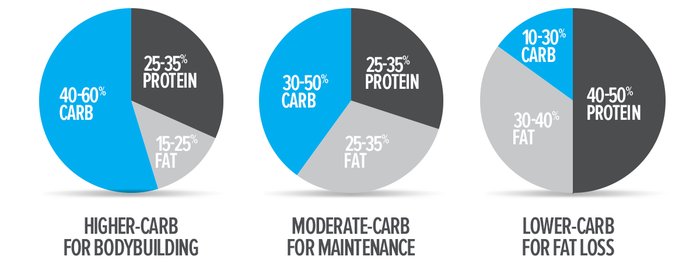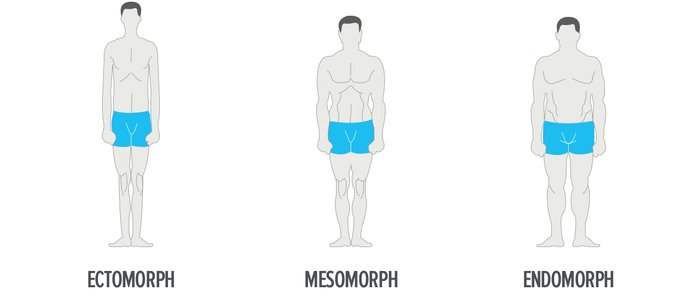I often get asked questions like, "What amounts of carbohydrates do you recommend for bulking?" "How much protein do I need during weight loss?" and "Is there an ideal macro ratio for getting rid of unwanted fat?" If you've ever asked someone these questions, you may have also tried a ratio you saw someone touting and found that it definitely didn't work for you. Maybe you felt groggy or exhausted all the time, or you expected gains that never showed up. This is all too common.
The truth is that just like everyone has different goals, everyone has to take a different road to get to their ideal body. Otherwise, building lean mass, shedding unwanted fat, and maintaining your goal weight would be easy—just adjust your calories and you'd be set! Sadly, it's not that simple.
Does this mean we're all doomed to start from scratch and tinker until we find our way? Definitely not. Here are three factors that can help you establish an effective starting point for your journey from "before" to "after."
Factor 1: Fitness Goals
Your first step is to choose what's more important to you: fat loss or lean mass gains. You may ask, "What if I want both?" However, this is one of those situations where you're better off tackling one goal at a time. While lean mass gains can occur alongside fat loss, neither process will occur at its full potential. Why? Higher carbohydrate ratios augment lean mass gains, while lower carbohydrate ratios tend to accelerate fat loss.
There are ways you can move incrementally toward fat and build muscle simultaneously, such as carb-cycling, where you alternate muscle-building phases of higher carbs with periods of lower carbs to encourage fat burning. Some recent research also supports intermittent fasting as a means of achieving both fat loss and mass gains. However, individual results vary in both cases, and neither is an excuse to disregard your macros altogether.
Regardless of what method you choose, you'll see more pronounced mass gains, or more rapid fat loss, if you focus primarily on one main goal at a time. Many pro fitness athletes utilize a "building" phase lasting several weeks or months, followed by a "cutting" phase to achieve a well-developed, yet lean physique. This doesn't have to be extreme or unpleasant in order to work, as long as you stick to these typical macronutrient ranges.
Macronutrient Ratios

Notice that fat never goes below 15 percent of total calories. Since hormones are constructed from cholesterol and other fat molecules, getting any less than that can actually suppress normal hormone levels. This also has a negative effect on the bodily functions driven by those hormones, including growth and development, metabolism, reproduction, and mood. Low fat intake can also impair absorption of the fat-soluble vitamins A, D, E, and K. Even worse, not getting enough essential fatty acids can increase your risk of colon cancer, breast cancer, and prostate cancer.
But as you might imagine, not just any fat source will do. Prioritizie healthy fat sources like monounsaturated fats like monounsaturated fats (avocados, egg yolks, olives, nuts, peanut butter, canola oil, olive oil, high-oleic sunflower oil), medium-chain triglycerides (coconut oil), and omega-3 fatty acids (salmon, and other fish, grass-fed beef, chia seeds, ground flax seeds, soybeans, tofu, edamame, beans, wild rice, and walnuts).
Factor 2: Body Type
Once you determined your primary fitness objective, it's important to factor in your body type. This will help determine how well you tolerate carbs and establish where in the above ranges you should start.
There are three general body types, with many people falling somewhere in between. While the endomorph could be considered the polar opposite of the ectomorph, many people are a combination of "endo/meso" or "ecto/meso." Even if you end up determining you're somewhere in the middle, these categories are helpful for establishing a nutritional benchmark. Start with the body type you most resemble, and tweak as necessary.

Ectomorph
An ectomorph is best described as slender. Characteristically, they have delicate bone structure, small shoulders and chest, and a fast metabolism. Ectomorphs are the classic "hardgainers." They find it hard to gain weight and put on mass.
On the plus side, it's easy for them to get lean. They tend to require a greater percentage of carbohydrates to prevent muscle catabolism, as well as a higher calorie intake overall.
Diet Recommendations: Ectomorphs should stick to the high end of the range for carbohydrates, between 30-60 percent of total calories, depending on whether the goal is mass gains, maintenance, or fat loss. Higher carbohydrate ratios augment lean mass gains, while lower carbohydrate ratios tend to accelerate fat loss.
I recommend the high end for mass gains, the mid-upper end for maintenance (45-55 percent), and the low-end for fat loss. At least 25 percent of total calories should come from protein, with the remainder from fat.
Mesomorph
A mesomorph is someone who trends toward being muscular. They're often strong, athletic hard-body types with well-defined muscles, broad shoulders, and dense bone structure. Mesomorphs generally have little trouble gaining muscle or losing fat, though they will put on fat more readily than ectomorphs.
They can handle a moderate level of carbs due to their ample capacity to store muscle glycogen. Weight gain will happen, however, if carbs and calories are overly high. No body type is immune to a bad diet!
Diet Recommendations: Mesomorphs do well in the middle range for carbohydrates, between 20-50 percent of total calories. Again, I recommend the high-end for mass gains (40-50 percent), the middle for maintenance (30-40), and low-end for fat loss (20-30).
To prioritize fat loss, increase both protein and fat while lowering carbohydrate intakes, with no more than 40 of calories coming from fat.
Endomorph
The endomorph is best described as soft. They typically have a round or pear-shaped body, shorter limbs, a stocky build, and a slower metabolism.
Endomorphs can put on a lot of muscle, but they also tend to carry more adipose tissue and thus have a greater propensity to store fat. Because excess carbohydrates in the endomorph's diet end up as fat, a high carbohydrate intake will make it difficult for them to get lean or lose weight.
Diet Recommendations: Endomorphs should stick to the low end of the carbohydrate range, between 10-40 percent of total calories, depending on their goals. Here, I recommend no more than 30-40 percent carbohydrates for mass gains, the middle range for maintenance (20-30), and low-end for fat loss (10-20).
As with the other body types, protein and fat provide the remainder of your calories, with 25-50 percent of total calories from protein and 15-40 percent from fat.
Factor 3: Gender

Gender is usually less pronounced of a factor than goals or overall body type, and it's far more prone to individual variation. However, it's nevertheless important for you to keep somewhat in mind as you work to find your ideal number.
In general, women are more efficient at burning fat and less efficient at burning the glycogen stored in muscle. As such, they may be able to operate on lower carbohydrate intake than men.
Research suggests a variety of reasons that women have a greater reliance on fats for fuel during exercise, including:
- Estrogen enhances epinephrine production, the primary hormone that stimulates lipolysis (fatty acid breakdown).
- Estrogen promotes the release of human growth hormone (HGH), which inhibits the uptake of carbohydrates and increases the mobilization of fatty acids from adipose tissue.
- Women have increased blood flow to adipose tissue, which could assist in fatty acid mobilization.
- Women have higher levels of intramuscular triglycerides (IMTG), a fat-based source of fuel that spares muscle glycogen during moderate to high intensity exercise. This sparing of muscle glycogen may actually give women an endurance edge when performing at high intensities against men!
- According to one study, men appear to rely more on stored carbohydrate for fuel than women when doing the same exercise.
Diet recommendation: Does this mean that women should always have a lower carb intake than men? Not necessarily. An ectomorphic woman training at high intensity would likely need a higher carbohydrate percentage than a sedentary endomorphic man.
On the other hand, a mesomorphic male trying to maintain weight would likely require a higher percentage of carbohydrate, perhaps in the range of 40 percent, while a woman of the same body type with the same goal may wish to start at around 30 percent.
Nevertheless, if you're a woman training at low to moderate intensity, I would suggest first referencing the above macro ranges to select a ratio that corresponds to your fitness goals and body type. Then, start on the low end for carbohydrates and see how you do.
Male or female, if you feel fatigued and weak from your workouts, yet you fail to build muscle mass, you should consider increasing your carbs.
Macros Are Just One Part Of The Puzzle
After the hundredth or so time that you hear "abs are made in the kitchen," it can be tempting to spend all your time worrying about macronutrient ratios and pay less mind to other factors that are just as important to your overall results. Don't lose the forest for the trees!

If your health was a math equation it would look like this: (x+y+z)(a+b+c)= u. There are hundreds of factors, and you must address them all to get the right answer.
One crucial additional factor is the total calories you take in. Even the perfect macronutrient ratio is ineffective if your calorie intake is too high or low. And along the same line, you can't expect to achieve a toned, muscular physique if you are unwilling to take training seriously!
This may sound like a lot to keep in mind, but don't get frustrated. You're building a healthier lifestyle here, not just doing math. Determining your ideal nutritional strategy will take time, and as your fitness goals evolve, your ideal macro ratio will too. But with determination, resolve, and a willingness to change, you'll keep progressing toward great things.

